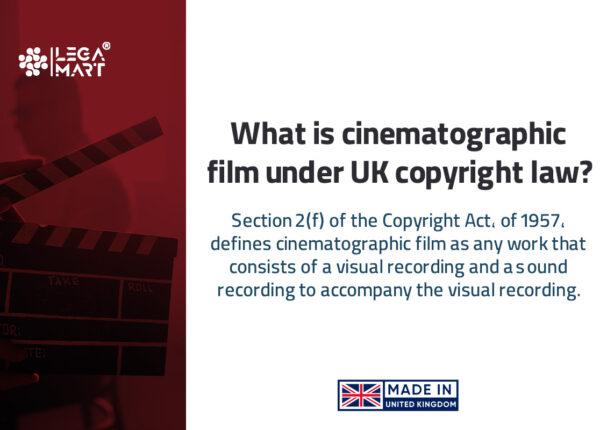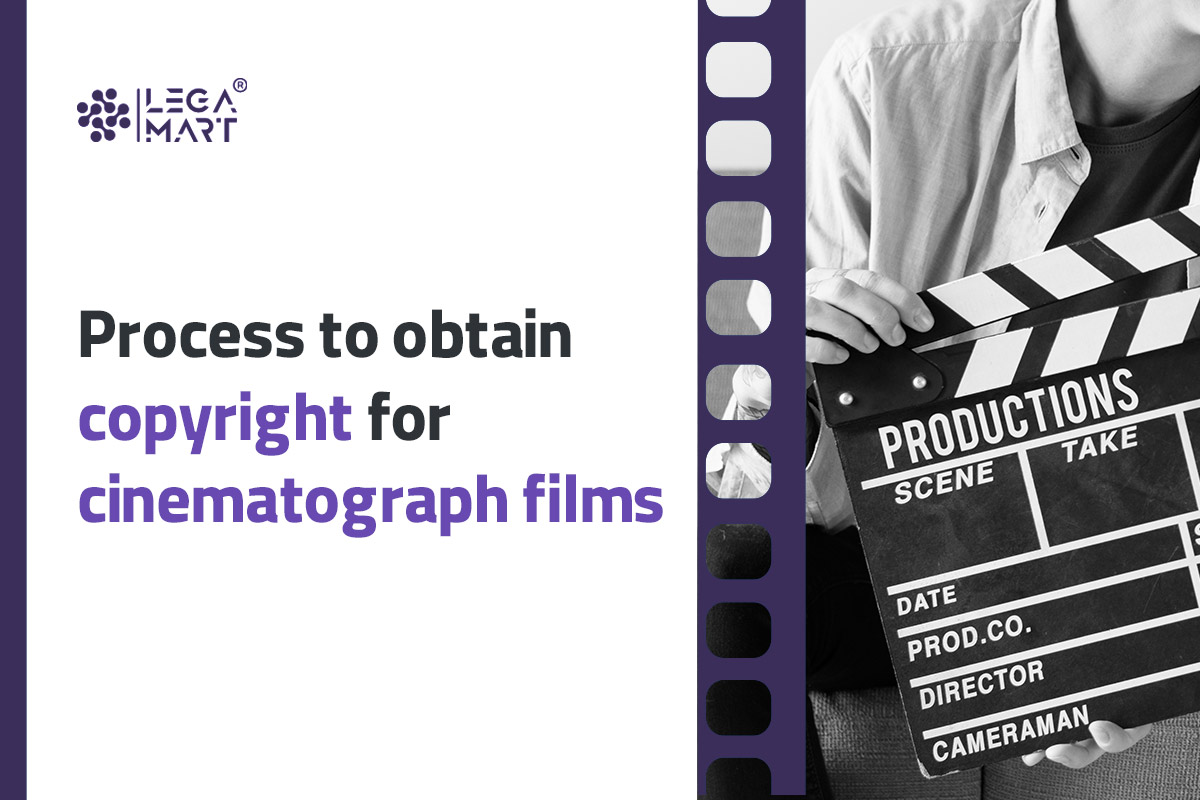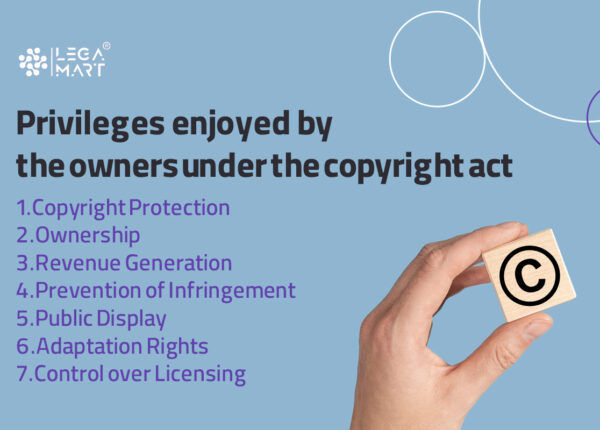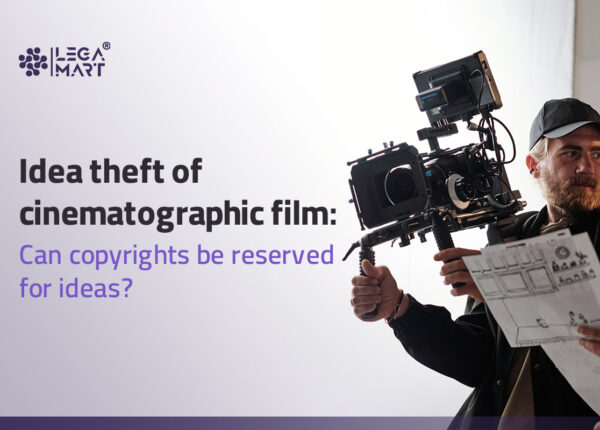Did you know the films you watch, sound recordings, or background music are all protected under copyright law?
Original works by creators are protected by copyright, a legal framework that has underpinned countless Case Studies & Success Stories by enabling creators to protect their unique artistic works and providing the original creator with exclusive rights and rewards. It’s important to note that a mere idea cannot be protected by copyright; if the idea is a creative work, it will be eligible to obtain copyright protection. This leads us to cinematograph film copyright.
For example, a cinematographer has an idea to make a movie based on a unique plot, but he cannot claim copyright protection because it’s just a mere idea. However, if he implements the same idea and makes a movie or a video, the work can be protected under the Copyright law.
It’s interesting how copyright law works! So, those movies you watch and the catchy background music you hear? They’re all protected under copyright law. That’s because they’re considered original creations by their respective creators. Copyright is like a shield that gives these creators exclusive rights and rewards for their artistic work.
But here’s the catch: Copyright doesn’t protect just any old idea. If you have an idea for a movie plot, that idea alone can’t be copyrighted. You can get copyright protection when you turn that idea into an actual movie or video. We read about it later in the blog.
So,if you’re a cinematographer with a fantastic movie concept then you can’t copyright the concept itself because it’s just an idea. But if you roll up your sleeves, bring that idea to life, and make an awesome movie out of it, congratulations, your work can be protected under copyright law!
What are cinematographic films?

Cinematographic films, often called films or movies in general language, are a form of visual storytelling and entertainment that combines moving images, audio, and sometimes text to narrate or convey the story. Therefore, cinematographic films can be defined as visual work in any medium created through a method by which moving images can be created. Cinematograph includes any work that involves moving images or visuals.
To understand the definitions from the legal perspective, let’s take an example of the UK Copyright Act of 1956, which defines cinematographic film under Section 13, which states that Cinematograph films are the sequence of visual images which are capable of being shown as a moving image, or of being recorded on other material such as video tapes.
Not only the UK copyright law, the definition of cinematographic film is also mentioned under the Indian Copyright law. Under Section 2(f) of the Copyright Act of 1957, cinematographic film means any work that consists of a visual recording and a sound recording to accompany the visual recording.
In the age of advanced technologies, copying and distributing someone’s original work has become easy. Therefore, it’s crucial to know about three things that will be discussed in this article, the three things are as follows:
a. How can your work be registered?
b. How is copyright related to cinematographic films? and
c. How do the creators benefit?
Registration of copyright: India, UK, and USA
Why is Copyright registration necessary?
Copyright registration differs from one country to another. It is advisable to get your work registered for copyright protection even though it’s automatic because the documents you will receive after the registration can be used as evidence of copyright infringement or disputes occurring on your original creation.
Copyright registration will also prevent your work from being duplicated for a specific time. Similarly, in US copyright law, copyright registration is not mandatory, but enforcing exclusive rights through litigation is necessary. Registration under US copyright law helps you have a record of your work with US customs and border protection that will protect you from improper use of your work or infringement of your copyrighted work. Besides, while copyright laws are in place to safeguard your cinematograph film, it is essential to understand how these laws apply to your masterpiece and how they extend to the digital age, addressing challenges like copyright infringement in social media platforms.
Key elements of Copyright Registration
- Some prerequisites need to be followed for copyright registration, such as the work must be original, creative, and can be fixed in a tangible medium.
- The original author or the authorized person can reproduce or reuse his work under the copyright law.
- Privileges the copyright holder enjoys are the right to issue copies of his work, reproduce his work, or control the reproduction of his work by someone else, etc.
- Not everyone can opt for copyright protection. Only creative professionals, such as cinematographers, artists, musicians, authors, writers, etc., can opt for copyright protection and register their work under the Copyright law.
- The original works should be in a tangible form, which means the work must possess a physical form which can be felt or touched or have a concrete form.
Documents required for the copyright registration of movies
As the registration process differs in different countries, the documents required for copyright registration may also vary. For instance, In India, the documents required for the Copyright registration are:
- Complete details of the applicant.
- The author or owner of the copyright must sign Form XIV and SOP (Statement of Particulars).
- If the work is published, then 1 copy is required. 2 copies if it’s unpublished.
- Power of Attorney is needed If the filling is done by a representative or an advocate and not by the applicant.
- NOC (No objection Certificate) is required if more than one applicant is involved.
- Statement of further Particulars is required for other copyrighted works but not for cinematograph films.
As another example, under the US copyright law, an applicant needs to submit three items:
- A complete application form which can be sent on online mode.
- Filing fee (non-refundable).
- One copy of the work.
Process to obtain copyright for cinematograph films

India
- After the applicant submits his application, it is duly checked by the copyright officer to ensure that all the submitted documents are attached to the application. In case of any missing document, the copyright officer sends a letter to the applicant.
- The work will be advertised for one month to invite any objections raised by anyone interested in the subject matter or who disapproves of the copyright protection provided to the applicant. If objections are raised, then both parties will be called to reply in writing, and further, it would be heard by the registrar.
- If no objections are raised, then a further process will be held. In case of discrepancy, the applicant will be advised to make the relevant changes, and after the changes are made, it will be passed for registration.
- After the completion of the examination process, registration will take place, and upon completion, a registration certificate will be issued to the applicant.
- The duration of copyright protection for cinematograph films is 60 years, according to the Copyright Act of 1957.
UK
Copyright protection in the UK is provided following the UK Copyright, Designs and Patents Act 1988. Like other countries, the UK only provides copyright protection for expressing an idea, not just a mere idea.
There are no formal procedures to apply for copyright protection in the UK. Copyright protection is obtained since the day the work has been created, and it shall be protected under the UK copyright law. However, as per the recommendations of the British Copyright Council, creators or authors must have self-recording as evidence in case any third party tries to violate the copyright law. The act of self-recording can be done in many ways, such as:
- A creator or author can send a copy of his work by sealing it properly and writing the name and date of creation.
- The author may also send copies of his work to his legal advisor, any entity, or any other authority that can keep his work safe.
- The author can employ any private entities or companies to support him in case of any disputes. Please note that these private entities don’t work under the UK government and own a separate company to assist in disputes.
US
Apart from filling out the application and sending the application form to the US Copyright Office, it is the responsibility of the owner to look out for any possibility of infringement and protect the copyright internationally. As the US copyright is complex, therefore, the copyright laws should be enforced when all the other methods don’t work. If the situation demands, hiring a professional LegaMart lawyer to look after the copyright disputes is highly recommended. These cases will proceed at civil courts or federal courts.
The duration of copyright of cinematograph films under the US copyright law is the life of the author in addition to 70 years or 95 years from the date of publication or 120 years from the date of creation of the work. Please note that this duration is for the works created on or after 1st January 1978.
For all the works that are created before the year 1978 are protected under the Copyright Act of 1909, which protects for the first 28 years and offers a chance to renew the protection. If the copyrighted work is not renewed or expired, it will be made available for anyone to use in the public domain.
Privileges enjoyed by the owners under the copyright act

The privileges enjoyed by the creators of cinematograph films are:
- Copyright protection: Creators have the exclusive right to reproduce, distribute, display, and perform their films. This legal protection prevents others from using their work without permission.
- Ownership: Creators retain ownership of their films, allowing them to control how their work is used, licensed, or sold.
- Revenue generation: Creators can earn income through various means, such as theatre screenings, streaming platforms, DVD sales, and licensing deals for international distribution.
- Prevention of infringement: Copyright protection enables creators to take legal action against anyone infringing on their film’s rights, potentially leading to monetary damages and injunctions.
- Public display: Creators can showcase their films in public venues like cinemas, festivals, or special events without concerns about violating copyright laws.
- Reproduction rights: Creators can make copies of their films for various purposes, including distribution, marketing, and archival purposes.
- Adaptation rights: Creators can adapt their films into other media forms, such as books, video games, or merchandise, potentially expanding their revenue streams.
- Control over licensing: Creators can license their films to third parties for specific uses or in specific regions, allowing for wider distribution while maintaining control.
These privileges empower cinematograph film creators to protect their work, generate income, and maintain creative control over their productions.
Benefits of copyright in cinematographic films
Copyright is a legal concept that grants exclusive rights to creators, ensuring that their original works cannot be used without permission. It covers various creative works like books, software, music, etc. Copyright protection safeguards creators from theft and unauthorized use, especially in today’s internet-driven world where content is easily accessible. Obtaining copyright offers several advantages, including legal ownership protection, revenue generation, prevention of infringement and monetary damages, the ability to display work publicly without fear, and the freedom to reproduce the work.
Copyright and the areas of cinematographic film
Effects of censorship on copyright
Censorship is a word used to define when an idea, word or image is suppressed because it’s offensive. Censorship affects copyright when a creator of the cinematograph film commits an offence of censorship in film and is liable for that offence; here, the main question arises whether the creator committing the offence of censorship will have any effect on his exclusive rights or the benefits he’s receiving under the copyright law.
However, the Copyright Act only states the rights of the creator, and the effects of copyright only depend upon the provisions of the Copyright Act; therefore, if the creator fails to comply with the laws relating to the censorship of films, then it wouldn’t affect his copyright over the work.
Performance of artist in movie
The performance of an actor is not protected under the Copyright Act. However, the Rome convention has established new provisions under the Copyright law by introducing performer’s rights. Here, the term “performers” includes actors, singers, musicians, dancers or any performers who work on artistic or literary work. They are protected for some acts for which they have not consented. Such acts include:
- Broadcasting and communication with the audience.
- Fixing the live performances.
- Making a copy of such fixations, whether made not with their consent or with their consent for any other purposes.
The broadcasting authorities enjoy such rights to prohibit the reproduction of their work, fixation of broadcasting, or reproduction of such fixations.
Copyright in lyric, music and creator of cinematograph film
You must know that most of the films or short videos consist of some music or song as a part of it. As these music, songs, and lyrics are a part of cinematographic films, they need copyright protection to prevent infringement or violation. However, the author or the producer of music has their rights to produce their work in public. Therefore, they have the authority to allow the creators of a cinematographic film to present their work as a part of their film in front of the public.
According to Section 14 of the Indian Copyright law, upon the completion of a cinematographic film, a copyright and the performer’s right are provided to the owner as the music or song or the lyric may have some visual images when it becomes a part of the cinematographic film which would be seen and heard in public. It is important to note that no permission or consent will be taken from the author or producer for the work being performed publicly.
In other words, the author or the producer who has provided the authority and permission to the creator of cinematographic film to use his musical or sound recording or lyric work as an acoustic portion of the cinematographic film cannot restrain the creator of the film from using or representing it in public for making profits in any way. The author or producer of the music or lyric cannot restrain the creator of the cinematographic film from projecting his work on radio channels or promoting his film on radio channels or any broadcasting channels.
As per the Copyright Act, the creator of cinematographic film has the authority to do all the things mentioned above as per his wishes. He is not prohibited from distributing his cinematographic work just because some part of the film belongs to the music composer or producer.
Check-out our next interesting blog in the series on 5 tips for copyright infringement: social media channels
Sound recording
Sound recording can be defined as recording a sound irrespective of the medium or method by which the sounds can be produced. A sound recording can be protected under the Copyright law only if the sound recording is made as per the Copyright provisions. In general, the owner of a sound recording does not possess the exclusive rights to perform it publicly according to the Copyright law, or the copyright will not exist if the work has been infringed. However, an owner of the sound recording may perform publicly through digital audio transmission.
As per the UK Copyright, Designs and Patent Act, 1988, the term “Sound recording” is defined as follows:
- It is a recording of sound from which the sound may be reproduced, or
- It is a recording of the sound of the whole part or any part of a literary, musical, or dramatic work. The same can be reproduced in different ways irrespective of the medium or process used to develop the sound recording.
In addition to what was said about cinematograph film copyright, the Copyright protection doesn’t exist for the authors who copy a copyrighted sound recording.
Idea theft of cinematographic film

To understand the concept of idea theft, we first have to learn the difference between idea theft and copyright infringement. It is to be noted that ideas cannot be copyrighted and cannot be infringed because they are considered as free as the air; however, you can protect certain specific expressions of those ideas in tangible forms, such as the creation of a movie or a cinematographic film. Moreover, if someone infringes on your right after expressing your idea, it is considered copyright infringement.
Now, to understand the concept of idea theft, we have to take an example; that is, in industries such as Hollywood, you might share an idea or submit the script with the expectation of being paid for that idea even though that idea is not copyrighted because it is not yet made into the tangible form such as a screenplay or a film, yet your idea can be protected. The concept of implied agreement forms between the person who gave the idea and the producer regarding the idea, and if the producer uses your idea without compensating you, then it is considered a breach of an implied contract.
5 cinematographic movies that were accused of copyright infringement
These cases involving accusations of copyright infringement or idea theft in the film industry certainly add interesting twists to the stories behind these well-known movies:
Zootopia: Gary L. Goldman’s copyright infringement claim against Disney for “Zootopia” didn’t hold up in court. While similarities were noted, they were not deemed significant enough to warrant a lawsuit.
Avatar: Despite facing several lawsuits, including one related to alleged plagiarism of fantasy artwork, James Cameron’s “Avatar” became a massive success and won numerous awards. The legal claims against the film were ultimately dismissed.
Finding Nemo: Accusations of copyright infringement were turned on their head when it was revealed that the accuser had stolen the idea from “Finding Nemo.” The fraudulent accuser faced legal consequences.
The Cabin in the Woods: A lawsuit claiming that the film was stolen from a novel is ongoing, with no resolution yet.
Titanic: The court dismissed a lawsuit alleging that the film copied a character from an unpublished biography, citing that the similarities were only “scenes a faire.”
Concluding cinematograph film copyright
To sum up, the copyright laws can vary from country to country. In the case of cinematographic films, copyright laws have produced a wide range of provisions which show that copyright protection is vital for protecting a creative work. Once you obtain copyright protection, no one can reproduce and own your work for their benefit. Copyright protection is available for cinematographic films that include music, lyrics, sound recordings, etc., except for the actors who act in the films. The actors don’t get copyright protection for their acting skills but have the performer’s rights.
Frequently asked questions
Can we protect the movie titles under the Copyright law?
No. The names of a movie cannot be copyrighted because it doesn’t come under the category of “creative works”. However, you can apply for trademark protection for the movie titles.
Which movies/films are not allowed for copyright protection?
Generally, copyright protection is based on the type of creative work, not the content, especially for cinematographic works. Although countries have different copyright laws, they generally provide copyright protection for all types of movies and films.
Who owns the copyright for cinematographic films?
Usually, the production company, scriptwriter, director, or cinematographer owns the copyright. They usually get into a work-for-hire contract.




